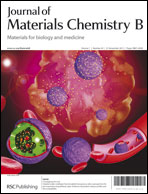Ethylene glycol oligomer modified-sodium alginate for efficiently improving the drug loading and the tumor therapeutic effect†
Abstract
The high viscosity of sodium alginate (ALG) causes its insufficient drug loading and limits its application as a drug carrier. In the present work, we synthesized poly(ethylene glycol) oligomer (mOEG)-modified sodium alginate (ALG–mOEG) and characterized its properties as a drug delivery system. Our results showed that ALG–mOEG displayed a greatly reduced viscosity (0.024 Pa s at 2.0 wt%) with a significantly improved drug loading capacity (18.0% (w/w)) compared with unmodified ALG (6.9% (w/w)). In addition, DOX–ALG–mOEG nanoparticles (DOX–ALG–mOEG NPs) with high drug loading were more cytotoxic for HepG2 cells in vitro and showed a higher antitumor activity in vivo compared with the control group (DOX–ALG NPs) at the same dose of DOX. DOX–ALG–mOEG NPs inhibited HepG2 proliferation in vitro with an IC50 value of 220.0 ng mL−1 and reduced tumor growth in vivo by 75.6%, while DOX–ALG NPs showed activities of 443.9 ng mL−1 and 62.7%, respectively. Meanwhile, we did not observe the “accelerated blood clearance (ABC)” phenomenon in these mOEG-modified ALG nanoparticles. In view of most biologic and chemical molecules used for the biological function being hydrophobic, we thought the ALG–mOEG scaffold also might serve as an efficient long-duration carrier for other hydrophobic molecules with minimal immunogenicity.


 Please wait while we load your content...
Please wait while we load your content...